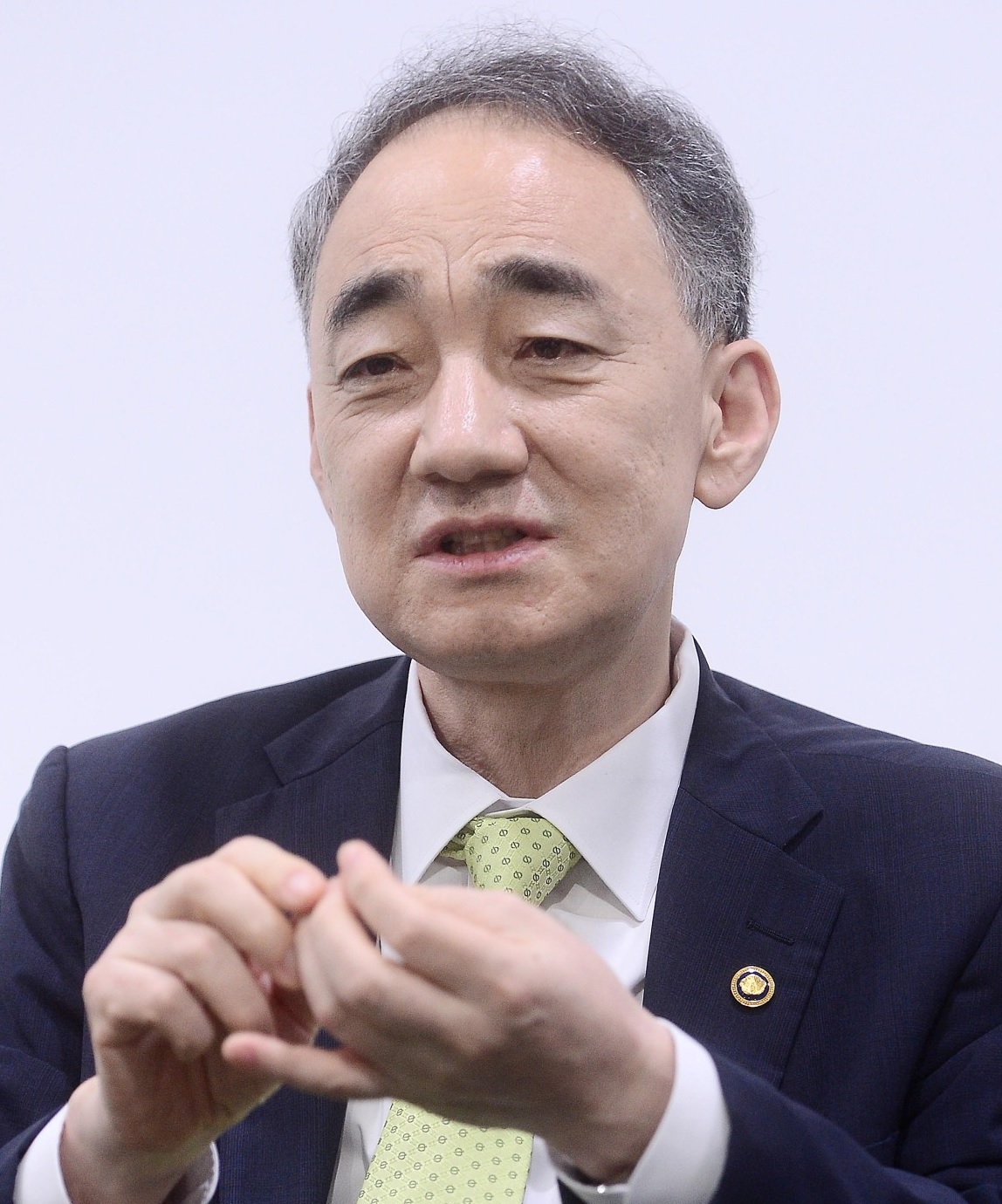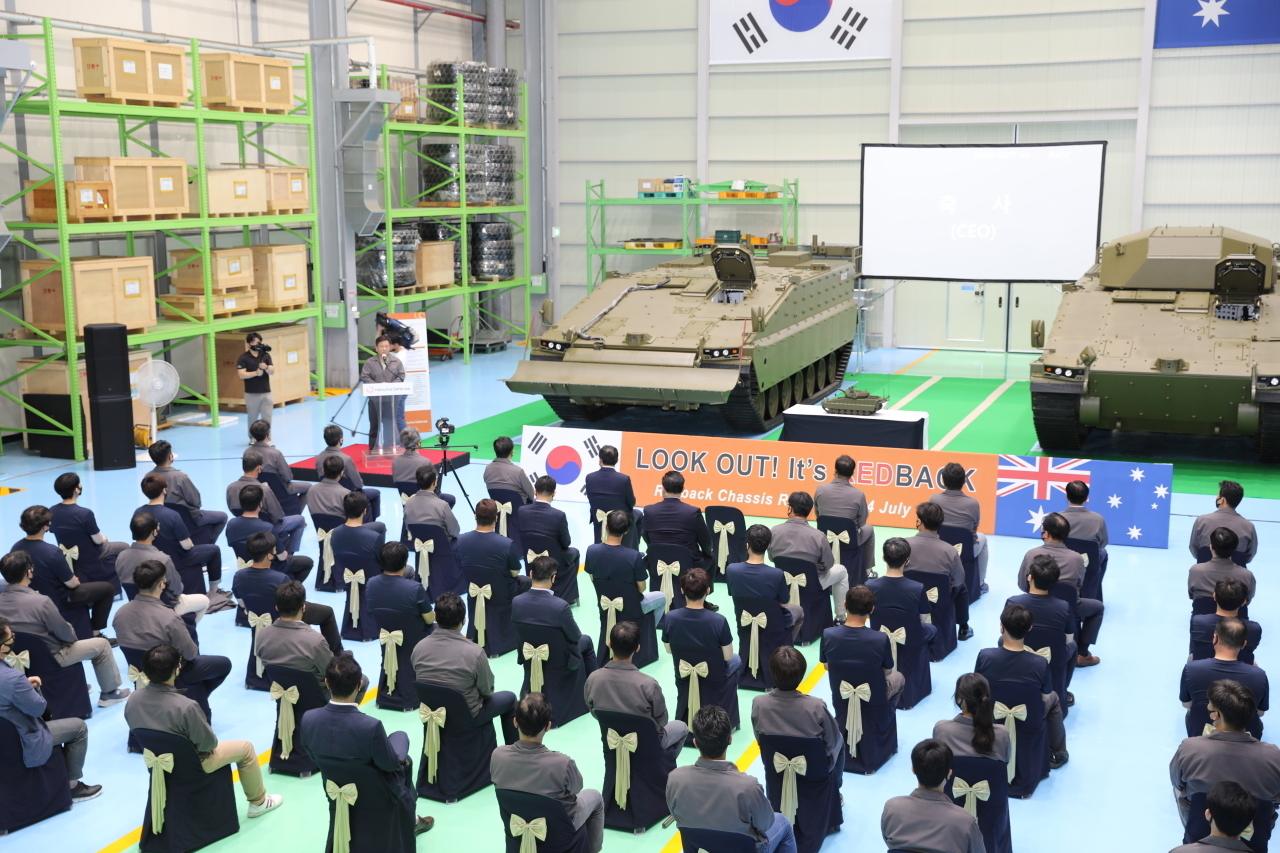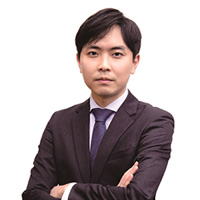[Herald Interview] Arms procurement chief lauds ‘hidden’ defense tech champions
Veteran state auditor becomes go-to troubleshooter for local defense firms looking to tap global market
By Choi Si-youngPublished : Aug. 4, 2020 - 14:59

Wang Jung-hong, a state auditor for 29 years, was appointed chief of the Defense Acquisition Program Administration in August 2018, amid hope for fairness, openness and greater accountability in arms procurement deals for the South Korean military, ranked the world’s sixth powerful.
Wang’s mission as the chief weapons buyer for the armed forces, however, went far beyond that.
As the country looked to spend more money on buying locally built weapons, he forged a team, including himself, in November that year, just three months into the job. They launched the “DAPA on the go” program, aka DAPA-Go, visiting a local defense company every week and meeting with key officials there.
The result, Wang said during a recent interview with The Korea Herald, is the discovery of “hidden tech champions” that could potentially help Korea build a foothold as a world-class arms maker.
“There are actually more promising homegrown defense companies than we think,” said Wang, who was formerly secretary-general at the Board of Audit and Inspection.
The weekly one-on-one engagement, which was originally intended at lending an ear to small and medium-sized contractors, naturally developed into a one-on-one consulting service.
The focus is often on how to sell globally, as many face dwindling sales at home. In 2017, the aggregate revenue of DAPA’s 93 local contractors fell for the first time since 1983, when data compilation began, on the back of a decline in overseas sales. “DAPA-Go” has a sound similar to the Korean phrase for sell everything.
“Some small companies have missed out on signing attractive deals with foreign buyers because they didn’t know how. They have never done it before,” Wang explained.
“The visit is an opportunity for local contractors to openly share their strengths, while privately communicating weaknesses,” he added.
The official setting of the DAPA-Go session ensures each company gets a fair chance of putting out wares to perhaps draw an appealing arms offer in the long run.
“It is strictly business, meaning we go in, listen up and offer solutions on the site, or if that’s not feasible, within seven days,” he said, stressing that he tries to make it an honest, two-way communication for mutual benefits and not about developing cozy personal ties.
So far, he and the DAPA-Go team have visited 65 contractors and gone as far as the southeastern port city of Busan.
Wang said Korea’s defense industry is making strides toward becoming an emerging player in the global arms market, which has long been dominated by the US and a few other traditional military powers.
He said the KF-X project that aims to locally develop next-generation fighter jets will be a milestone in the country’s effort to transform from a major arms buyer to exporter on the world stage.
The high-profile project, led by the Agency for Defense Development, is the largest undertaking ever by the Korean military, with some $15 billion earmarked for investment until mass production. Wang’s agency has jurisdiction over the ADD.
“The prototype is coming out next year, and a year later in 2022 we will see its first test flight,” Wang said, adding mass production is expected to begin as early as 2026.
The advanced fighter jet will boast a locally made cutting-edge active electronically scanned array radar, which experts say is the culmination of Korea’s homegrown aerospace technologies. A prototype of the key radar is set to be unveiled this month.
The AESA radar was originally one of the four key technologies the US promised to transfer to Korea as part of an arms deal involving Seoul’s purchase of stealth aircraft F-35s from US defense contractor Lockheed Martin. But the US Congress objected to the transfer.
The agency is determined to nurture homegrown technologies for ground weapons as well. The agency is currently seeking a wholly domestic powertrain for Korea’s main battle tank K2.
“We’re third to have come up with the 1,500-horsepower powertrain technology, after Germany and the US. Rules have hampered a product launch, but we’ve cleared that up,” he said, noting the agency was eyeing countries in Europe and the Middle East for export.
Wang’s mission as the chief weapons buyer for the armed forces, however, went far beyond that.
As the country looked to spend more money on buying locally built weapons, he forged a team, including himself, in November that year, just three months into the job. They launched the “DAPA on the go” program, aka DAPA-Go, visiting a local defense company every week and meeting with key officials there.
The result, Wang said during a recent interview with The Korea Herald, is the discovery of “hidden tech champions” that could potentially help Korea build a foothold as a world-class arms maker.
“There are actually more promising homegrown defense companies than we think,” said Wang, who was formerly secretary-general at the Board of Audit and Inspection.
The weekly one-on-one engagement, which was originally intended at lending an ear to small and medium-sized contractors, naturally developed into a one-on-one consulting service.
The focus is often on how to sell globally, as many face dwindling sales at home. In 2017, the aggregate revenue of DAPA’s 93 local contractors fell for the first time since 1983, when data compilation began, on the back of a decline in overseas sales. “DAPA-Go” has a sound similar to the Korean phrase for sell everything.
“Some small companies have missed out on signing attractive deals with foreign buyers because they didn’t know how. They have never done it before,” Wang explained.
“The visit is an opportunity for local contractors to openly share their strengths, while privately communicating weaknesses,” he added.
The official setting of the DAPA-Go session ensures each company gets a fair chance of putting out wares to perhaps draw an appealing arms offer in the long run.
“It is strictly business, meaning we go in, listen up and offer solutions on the site, or if that’s not feasible, within seven days,” he said, stressing that he tries to make it an honest, two-way communication for mutual benefits and not about developing cozy personal ties.
So far, he and the DAPA-Go team have visited 65 contractors and gone as far as the southeastern port city of Busan.
Wang said Korea’s defense industry is making strides toward becoming an emerging player in the global arms market, which has long been dominated by the US and a few other traditional military powers.
He said the KF-X project that aims to locally develop next-generation fighter jets will be a milestone in the country’s effort to transform from a major arms buyer to exporter on the world stage.
The high-profile project, led by the Agency for Defense Development, is the largest undertaking ever by the Korean military, with some $15 billion earmarked for investment until mass production. Wang’s agency has jurisdiction over the ADD.
“The prototype is coming out next year, and a year later in 2022 we will see its first test flight,” Wang said, adding mass production is expected to begin as early as 2026.
The advanced fighter jet will boast a locally made cutting-edge active electronically scanned array radar, which experts say is the culmination of Korea’s homegrown aerospace technologies. A prototype of the key radar is set to be unveiled this month.
The AESA radar was originally one of the four key technologies the US promised to transfer to Korea as part of an arms deal involving Seoul’s purchase of stealth aircraft F-35s from US defense contractor Lockheed Martin. But the US Congress objected to the transfer.
The agency is determined to nurture homegrown technologies for ground weapons as well. The agency is currently seeking a wholly domestic powertrain for Korea’s main battle tank K2.
“We’re third to have come up with the 1,500-horsepower powertrain technology, after Germany and the US. Rules have hampered a product launch, but we’ve cleared that up,” he said, noting the agency was eyeing countries in Europe and the Middle East for export.

On July 28, Korean company Hanwha Defense shipped prototype Redback infantry fighting vehicles to the Australian Army, hoping to clinch a deal worth roughly $4.1 billion. With Germany as the sole contender, Korea is only a step away from a first-ever deal to export critical military equipment to a key military power.
A successful bid there is also expected to boost Korea’s chances for a US project to replace Bradley fighting vehicles, for which bidding is set to open early next year.
To further nurture the local weapons industry, Korea needs a two-track strategy, Wang said.
First is to have the ADD, handling research and development in weapons technology, dedicate resources to producing core technologies that require long-term investment and strategy. The research body has already identified some 30 areas of technology to focus on, according to Wang.
Meanwhile, private companies, helped by experts from academia as well as DAPA, could race to roll out weapons immediately adaptable to battlefields, Wang added.
To spur bold investments in future technologies, Wang’s agency has drafted two legislative bills, which both passed the parliament earlier this year to take effect next year.
The bills empower the agency chief to declare key defense projects a national priority to receive more government funds. They also provide a fresh waiver to companies failing to deliver end products on government subsidies, as long as they have shown dedicated endeavors.
Defense companies and the government will also be able to jointly claim rights to technologies produced through their collaboration. The change is expected to incentivize more contractors to take part in joint efforts for weapons development.
Identifying local tech champions and helping them produce competitive equipment for the Korean military as well as the armed forces overseas is a key task, but the basis of all those efforts should be a fair and transparent process, Wang stressed.
“We need to deliver (the best) equipment to the military on time and through orders placed without favor or prejudice,” he said, adding the agency should also be more agile in putting change into action.
Wang was appointed to lead the agency amid a corruption scandal where defense companies were accused of wrongdoings, including accounting and tax fraud.
“Shock therapy,” he said in referring to his appointment, adding he hopes to help defeat public distrust of the agency. “Once trust is restored, an expert should take the helm.”
By Choi Si-young (siyoungchoi@heraldcorp.com)
A successful bid there is also expected to boost Korea’s chances for a US project to replace Bradley fighting vehicles, for which bidding is set to open early next year.
To further nurture the local weapons industry, Korea needs a two-track strategy, Wang said.
First is to have the ADD, handling research and development in weapons technology, dedicate resources to producing core technologies that require long-term investment and strategy. The research body has already identified some 30 areas of technology to focus on, according to Wang.
Meanwhile, private companies, helped by experts from academia as well as DAPA, could race to roll out weapons immediately adaptable to battlefields, Wang added.
To spur bold investments in future technologies, Wang’s agency has drafted two legislative bills, which both passed the parliament earlier this year to take effect next year.
The bills empower the agency chief to declare key defense projects a national priority to receive more government funds. They also provide a fresh waiver to companies failing to deliver end products on government subsidies, as long as they have shown dedicated endeavors.
Defense companies and the government will also be able to jointly claim rights to technologies produced through their collaboration. The change is expected to incentivize more contractors to take part in joint efforts for weapons development.
Identifying local tech champions and helping them produce competitive equipment for the Korean military as well as the armed forces overseas is a key task, but the basis of all those efforts should be a fair and transparent process, Wang stressed.
“We need to deliver (the best) equipment to the military on time and through orders placed without favor or prejudice,” he said, adding the agency should also be more agile in putting change into action.
Wang was appointed to lead the agency amid a corruption scandal where defense companies were accused of wrongdoings, including accounting and tax fraud.
“Shock therapy,” he said in referring to his appointment, adding he hopes to help defeat public distrust of the agency. “Once trust is restored, an expert should take the helm.”
By Choi Si-young (siyoungchoi@heraldcorp.com)











![[Today’s K-pop] BTS pop-up event to come to Seoul](http://res.heraldm.com/phpwas/restmb_idxmake.php?idx=644&simg=/content/image/2024/04/17/20240417050734_0.jpg&u=)





![[KH Explains] Hyundai's full hybrid edge to pay off amid slow transition to pure EVs](http://res.heraldm.com/phpwas/restmb_idxmake.php?idx=652&simg=/content/image/2024/04/18/20240418050645_0.jpg&u=20240418181020)

![[Today’s K-pop] Zico drops snippet of collaboration with Jennie](http://res.heraldm.com/phpwas/restmb_idxmake.php?idx=642&simg=/content/image/2024/04/18/20240418050702_0.jpg&u=)